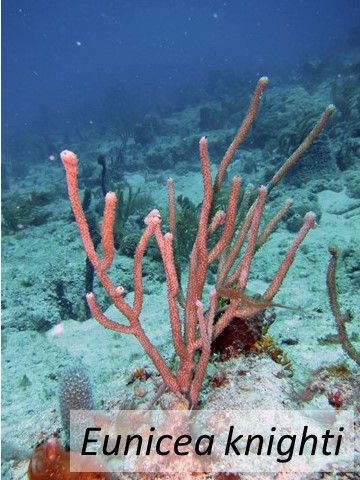
Family: Plexauridae
Common Name(s): Knight’s flexible sea rod
Colony Form: Treelike, elastic/flexible, bushy with well-spaced dichotomous branching from near colony base, to ~1.5 m tall.
Axis: Cylindrical
Branches: Long terminal branches <50% colony height, ~5 mm across at tips, with knobs at ends and occasionally at mid-branch.
Apertures: Smooth round pores; edges raised with 8 inner lobes when expanded; dries smooth.
Mucus: Slick or slimy.
Color: Reddish brown to dark ochre; also beige, pale purple or purplish gray in situ; dries gray to pale ochre. Reddish when fixed in alcohol.
Sclerites: Polyp armature: diverse ornate sclerites. Axial layer: pale purple sclerites, generally short (< 0.17 mm) with two or three notable ornaments on each side. Middle layer: ornate spindles to 1 mm long. Surface layer: many torch clubs with congruent rows of ornaments on handle.
Habitat: Reefs and hardbottoms in depths of 13-27 m; usually the deepest part of the reef but also in shallower protected parts.
Distribution: Bahamas, South Florida, Gulf of Mexico, and Caribbean Sea
Notes: Often grows on hard substrates buried in sediment. This species can be confused with Pseudoplexaura species, but E. knighti has large dark extended polyps, and a small piece placed in ethanol turns reddish.
References: Bayer (1961), Cairns (1977), Collin et al. (2005), Sanchez (2009), van Ofwegen (2010).
Similar Species: Eunicea pinta; Pseudoplexaura crucis; Pseudoplexaura flagellosa; Pseudoplexaura porosa; Pseudoplexaura wagenaari












